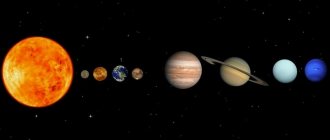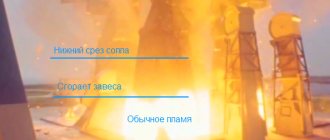Saturn's satellite Titan is one of the most mysterious and interesting worlds located literally next door to us. In general, our Solar system is so diverse and contains its own worlds so different from each other that the most bizarre conditions and phenomena can be found here. Lava lakes and water volcanoes, seas of methane and almost supersonic hurricanes - all this is literally next door.
Our closest neighbors are much more interesting than people think. And now you will learn about one of them - a satellite of Saturn named Titan. This is an amazing place, unlike any other.
Interesting facts about Saturn's moon Titan
Titan is a unique place that has no analogues in the solar system.
- Titan is the largest satellite of Saturn and the second largest satellite in the Solar System in general after Ganymede, a satellite of Jupiter. It is larger than the Moon and even Mercury, which is an independent planet.
- Titan is 80% heavier than the Moon, and in general its mass is 95% of the mass of all satellites of Saturn.
- Titan has a very dense atmosphere, which no other satellite, or even every planet, can boast of. For example, Mercury has practically no energy, while Mars has much more rarefied energy. Even the earth’s atmosphere is much inferior in density - the pressure at the surface there is 1.5 times greater than the earth’s, and the thickness of the atmosphere is 10 times greater.
- Titan's atmosphere is composed of methane and nitrogen and is completely opaque due to clouds in the upper layers. The surface cannot be seen through it.
- On the surface of Titan, rivers flow and there are lakes and even seas. But they do not consist of water, but of liquid methane and ethane. That is, this satellite of Saturn is completely covered with hydrocarbons.
- In 2005, the Huygens probe landed on Titan and was delivered there by the Cassini spacecraft. The probe not only took the first photographs of the surface during its descent, but also transmitted a recording of wind noise.
- Titan does not have its own magnetic field.
- Titan's sky is yellow-orange.
- Winds constantly blow on Titan and hurricanes often occur, especially violent movement occurs in the upper layers of the atmosphere.
- Methane rain on Titan.
- The surface temperature is about -180 degrees Celsius.
- Under the surface of Titan there is an ocean of water laced with ammonia. The surface is predominantly composed of water ice.
- Titan has cryovolcanoes that erupt with water and liquid hydrocarbons.
- Titan is a promising place to search for extraterrestrial life, at least in the form of bacteria.
- Titan is geologically active.
This is the satellite of Saturn - seething, boiling and erupting, where instead of water there are mainly hydrocarbons, although there is also quite enough water. So it is no coincidence that scientists assume that some kind of primitive life can arise there - all the components for this are there, and the conditions are quite comfortable, even if not on the surface itself.
Titan, although not a planet, is the most Earth-like place in the solar system. The atmosphere, rivers, volcanoes, water - all this is there, although in a slightly different quality.
Description and map of the satellite's surface
Map of Titan's surface, with lakes marked on it. Credit: spacegid.com.
After receiving clearer images from the Cassini spacecraft, scientists were able to understand the structure of Titan. The geology is presumably young, with no major fractures, super volcanoes or deep chasms.
Titan Structure:
- atmosphere;
- surface;
- ice outer shell;
- global subsurface ocean layer;
- high pressure ice shell;
- hydrosilicate core with a radius of about 2000 km.
Cassini-Huygens is an automatic interplanetary station (AIS) for studying the planet Saturn, its rings and satellites. Credit: enciklopediya-tehniki.ru.
Continents, seas and rivers are clearly visible on the satellite. The structure of reservoirs is similar to what we see on Earth. Rivers have a delta, a source, and winding channels. Reservoirs occupy 30% of the satellite's total volume. The seas are composed of liquid methane, ethane and propane. It is assumed that there are also underground sources of liquid water.
The relief is mainly represented by plains and valleys. A large ridge of dunes has been spotted in the equator region.
When observed in some areas, tectonic activity is visible. The processes are caused by the gigantic gravity of Saturn.
Discovery of Titan
Christiaan Huygens
Saturn's moon Titan was discovered on March 25, 1655 by Christiaan Huygens, a Dutch astronomer, mathematician and physicist. He had a homemade 57mm telescope with a magnification of about 50x. Armed with it, Huygens observed the planets, and near Saturn he discovered a certain body that made a complete revolution around the planet in 16 days.
Until June, Huygens observed this strange object, until the rings of Saturn were at their smallest opening and began to interfere with observations. Then the scientist was convinced that it was a satellite of Saturn, and calculated its period of revolution - 16 days and 4 hours. He called it simply – Saturni Luna, that is, “Moon of Saturn.” After Galileo's discovery of the moons of Jupiter, this was the second discovery of a moon around another planet using a telescope.
The satellite received its modern name when John Herschel in 1847 proposed that all the satellites of Saturn be named after the setters and brothers of the god Saturn, and by that time there were seven of them known.
In 1907, Comas Sola, a Spanish astronomer, observed a phenomenon where the central part of its disk becomes brighter than the edges. This served as evidence of the presence of an atmosphere on Titan. In 1944, Gerard Kuiper used a spectrometer to determine that its atmosphere contained methane.
History of satellite discovery
In the middle of the 17th century. Christian Huygens, inspired by the example of the famous Galileo Galilei, created a powerful telescope to observe the solar system. Near the planet Saturn, a scientist noticed a bright celestial body that was moving in the orbit of the planet.
The object remained unnamed for 200 years. Titan received its modern name in 1847, when John Herschel published an article on astronomy. In it, he proposed the names of the sisters and brothers of Kronos from Greek mythology as names for the companions.
And although Titan, the satellite of Saturn, was discovered more than 400 years ago, its full study began only in the early 80s. XX century In 1980, the Hubble Space Telescope flew 7,000 km from its surface. But due to the dense atmosphere, it was not possible to see the relief in detail.
A breakthrough in the research occurred in 2004, when the interplanetary station entered the orbit of Saturn. Using radar and a camera with an infrared filter, the first images of Titan were taken. The photographs amazed scientists. The satellite traced mountain ranges, continental regions, seas and lakes.
Dimensions and orbit of Titan
The diameter of Titan is 5152 km, that is, 0.4 Earth's. It is the second largest moon in the entire solar system after Ganymede. Before the Voyager 1 flight, its diameter was considered 5550 km, that is, larger than Ganymede, and Titan was considered the record holder. However, it turned out that the error arose due to a very thick and opaque atmosphere, and the real size of the satellite itself turned out to be somewhat smaller.
Titan is 50% larger than the Moon and 80% heavier. The gravity on it is 1/7 that of Earth. It consists approximately equally of ice and rock. Europa, Callisto, and Ganymede have approximately the same structure.
Titan is a fairly large object, so it has a hot core and exhibits geological activity. However, the origin of this satellite is still unclear. The question remains open whether it was captured by Saturn from the outside or immediately formed in orbit from a gas and dust cloud. Since it is very different from the other satellites of Saturn, leaving them all with only 5% mass, the capture theory may well be correct.
The radius of Titan's orbit is 1,221,870 kilometers. It is located far beyond the outermost ring. Thanks to this distance from the planet, this satellite is clearly visible even with a small telescope. It completes a full revolution in 15 days, 22 hours and 41 minutes - Huygens was slightly mistaken in his calculations, although he calculated quite accurately with his simplest means of observation.
Distance
The closest distance between Titan and Earth is 1.2 billion kilometers, while Mars is 55 million, which is about 22 times closer than Titan.
And this is a big difference and the main obstacle to the colonization of Titan. However, it is worth noting that everything is not so simple here. Colonization is a much more complex matter than the comic project “Mars One”, which is gradually turning into MMM and I will mention it at the end of this article. A long flight imposes restrictions and increases risks and investments. But as I will tell you below, not everything is so sad, because... comparatively, much less equipment will be required for Titan than for Mars, therefore it is possible to increase the engine power of the future ship with settlers and the fuel supply, which will shorten the flight.
The problem is also the solar wind and cosmic radiation. Here you have protons, high-energy electrons and gamma rays; it is not so easy to protect yourself from all this variety of high-energy particles, and no lead plates will help here, because induced radiation is even more dangerous. However, there is no need to develop any fantastic shield of magnetic fields, nanoparticles or exotic matter; all this can be protected by a layer of water placed between the living compartment and the skin.
Another problem is weightlessness. In the absence of gravity, the human body is destroyed, calcium is washed out of the bones, the heart weakens, etc. Physical exercise won't help either, because... They only slow down these destructive processes. However, it is possible to design a future spaceship so that the living compartments are under the influence of centrifugal force; in other words, the colonists should be in a rotating ring, or the ship itself should rotate around its axis.
Atmosphere of Titan
What is remarkable about Titan is its luxurious atmosphere, which would be the envy of many terrestrial planets, except perhaps Venus. Its thickness is 400 km, which is ten times the Earth’s, and the pressure at the surface is 1.5 Earth’s atmospheres. Mars would definitely be jealous!
This is how Voyager saw Titan
Powerful winds blow in the upper layers, strong hurricanes occur, but only a weak breeze is felt near the surface. The higher you go, the stronger the winds; they coincide with the direction of rotation of the satellite. Above 120 km there is very strong turbulence. But at an altitude of 80 km, complete calm reigns - there is a certain zone of calm, where the wind from the lower regions and storms located above do not penetrate. It is possible that at this altitude, multidirectional air flows compensate and cancel each other out, although the exact nature of this phenomenon has not yet been clarified.
On Titan, it rains or snows from methane or ethane from methane and ethane clouds.
However, the composition of the air there is not at all pleasing - 95% nitrogen, and the rest is mainly methane. By the way, only on Earth and Titan the atmosphere consists mainly of nitrogen! In the upper layers of methane, under the influence of the Sun, the process of photolysis occurs and smog is formed from hydrocarbons, which we see in the form of a dense cloud curtain. This makes it impossible to see the surface of Titan.
The origin of such a vast atmosphere is still unclear, but the most plausible version seems to be the active bombardment of Titan by comets at the dawn of its formation, 4 billion years ago. When a comet collides with a surface rich in ammonia, a large amount of nitrogen is released under the influence of enormous pressure and temperature. Scientists calculated the atmospheric leakage and concluded that the original atmosphere was 30 times heavier than the current one! But even now she is not even frail.
The sky of Titan is approximately the same color as in the picture.
The upper layers of the atmosphere are exposed to sunlight, ultraviolet light and radiation. Therefore, there are constantly processes of splitting methane molecules into various hydrocarbon radicals and ions. Nitrogen ionization also occurs. As a result, these chemically active elements constantly form new organic compounds of nitrogen and carbon, including very complex ones. Just some kind of biofactory! It is these organic compounds that make Titan's atmosphere appear yellow.
According to calculations, all the methane in the atmosphere would theoretically be used up in 50 million years. However, the satellite has existed for billions of years and the methane in its atmosphere is not decreasing. This means that its reserves are constantly replenished, possibly due to volcanic activity. There are also theories that methane can be produced by special bacteria.
Colonization
Among all the moons, Titan seems to be the most profitable target for establishing a colony.
Artist's concept of a possible fleet developed by NASA
Titan has a huge amount of elements that are needed to support life: methane, nitrogen, water and ammonia. They can be transformed into oxygen and even create an atmosphere. The pressure is 1.5 times higher than Earth's, and the dense atmosphere protects much better from cosmic rays. Of course, it is filled with flammable substances, but an explosion requires a huge amount of oxygen.
But there is also a problem. Gravity is inferior to that of the Earth's Moon, which means the human body will have to fight against muscle atrophy and bone destruction.
It is not easy to cope with frost of -179°C. But the satellite is a tasty morsel for researchers. There is a high probability of encountering life forms that can survive in extreme conditions. Perhaps we will also come to colonization, because the satellite will become a starting point for the study of more distant objects and even exit from the system. Below is a map of Titan and high-quality, high-resolution photos from space.
Surface of Titan
The surface of Titan cannot be seen even when close to the satellite, not to mention earth-based telescopes. Thick clouds in the upper layers of the atmosphere are to blame. However, spacecraft have carried out some research in various bands and have revealed a lot about what is hidden under the clouds.
Moreover, in 2005, the Huygens probe separated from the Cassini station and descended directly onto the surface of Titan, transmitting the first real panoramic photographs. The descent through the thick atmosphere took more than two hours. And Cassini itself, over the years spent in orbit of Saturn, took many photographs of both the cloud cover of Titan and its surface in different ranges.
The mountains of Titan, photographed by the Huygens probe from an altitude of 10 km.
The surface of Titan is mostly flat, without strong differences. However, in some places there are also real mountain ranges up to 1 kilometer high. A mountain with a height of 3337 meters was also discovered. Also on the surface of Titan there are many lakes of ethane, and even entire seas - for example, the Kraken Sea is comparable in area to the Caspian Sea. There are many ethane rivers or their courses. At the landing site of the Huygens probe, many round stones are visible - this is a consequence of the influence of liquid on them; in earthly rivers, stones are also gradually ground down.
The stones at the landing site of the Huygens probe were round in shape.
Few craters have been found on the surface of Titan, only 7. The fact is that this satellite has a powerful atmosphere that protects against small meteorites. And if large ones fall, then the crater is quickly filled up with various sediments, collapses, eroded... In general, the weather does its job, and quite quickly all that remains of the huge crater is a neat depression. And most of Tatan’s surface still appears to be a white spot; only a small part of it has been studied.
One of the seas of Titan is the Sea of Ligeia with an area of 100,000 square meters. km.
Along the equator, Titan is surrounded by a curious formation, which scientists initially mistook for a methane sea. However, it turned out that these were dunes made of hydrocarbon dust, which fell as precipitation or was carried by wind from other latitudes. These dunes are located parallel and stretch for hundreds of kilometers.
Methane lakes
The bodies of water present on the surface of the planet and, possibly, under it also attract the attention of scientists. In particular, we are talking about hydrocarbon seas, methane lakes, and other similar compounds. The largest object, Kraken, is located on the north pole side. Its area reaches 400,000 square kilometers, and its depth is 160 m. There are other large seas. One of them is located near the north pole and is called Ligeia. Its area is 126,000 square kilometers. It was here in 2014 that NASA first discovered a mysterious object called “Magic Island”. These are not all interesting phenomena. The lion's share of reservoirs is concentrated in the polar parts. However, similar formations also exist on equatorial lines.
The structure of Titan's atmosphere
Titan structure
All information about the internal structure of Titan is based on calculations and observations of various processes on it. Inside it is a solid silicate core with a diameter of 3,400 km - it consists of ordinary rocks. Above it is a layer of very dense water ice. Then there is a layer of liquid water mixed with ammonia and another ice layer - the actual surface of the satellite. The top layer, in addition to ice, contains rocks and everything that falls in the form of precipitation.
The structure of Titan.
Saturn, with its powerful attraction, has a strong impact on Titan. Tidal forces “warp” it and cause the core to heat up and the movement of different layers. Therefore, volcanic activity is also observed on Titan - cryovolcanoes have been discovered there, which erupt not with lava, but with water and liquid hydrocarbons.
The structure of the satellite: from the outer shell to the core
Assumptions and conjectures about the structure of such a large celestial body were mainly based on data from terrestrial optical observations. The dense atmosphere of Titan inclined scientists towards the hypothesis that the gas composition of the satellite was akin to the composition of the mother planet. However, after the flights of the Pioneer 11 and Voyager 2 space probes, it became clear that we are dealing with a celestial body whose structure is solid and stable.
Titan structure
Today it is believed that Titan has a crust similar to the Earth's. The diameter of the core is approximately 3400 km, which is more than half the diameter of the celestial body. Between the core and the crust there is an ice layer that differs in composition. It is likely that at certain depths the ice transforms into a liquid structure. A comparison of images taken from the Cassini spacecraft with a difference of two years indicated the presence of a displacement of the surface layer of the satellite. This information gave scientists reason to believe that the surface of the satellite rests on a liquid layer, which consists of water and dissolved ammonia. The displacement of the crust is caused by the interaction of gravitational forces and atmospheric circulation.
Titan's composition is a mixture of ice and silicate rocks in equal proportions, which is very similar to the internal structure of Ganymede and Triton. However, due to the presence of a dense air shell, the structure of the satellite has its own differences and specifics.
Surface of Titan
Subsurface Ocean
The most curious thing about Titan is the possible presence of a subsurface ocean - that same water layer that is located between the surface and the core. If it actually exists, then it completely covers the entire satellite. According to calculations, the water in it contains about 10% ammonia, which serves as antifreeze and lowers the freezing point of water, so it must be there in liquid form. Also, water may contain a certain amount of different salts, as in terrestrial sea water.
According to data collected by Cassini, such a subsurface ocean should actually exist, but it is located at a depth of about 100 km from the surface. There is also evidence that the water contains large amounts of sodium, potassium and sulfur salts, and this water is very salty. Therefore, it is unlikely that any life is possible in it. However, this issue continues to concern scientists and is of great interest. Thanks to this, Titan has become a priority object for future research, as has Europa, a satellite of Jupiter, which also has a subsurface ocean. Scientists really want to go deep and see what is there in these oceans, especially to look for any forms of life.
Study
Saturn's rings often overlap the moon, making Titan difficult to find without special tools. But then there is a barrier from a dense atmospheric layer, which prevents us from viewing the surface.
Pioneer 11 first approached Titan in 1979, presenting photographs. He noted that the moon was too cold to support life forms. This was followed by Voyagers 1 (1980) and 2 (1981), which provided information on density, composition, temperatures and mass.
Titan imaged by Voyager 2 in 1981
The main information array came from the study of the Cassini-Huygens mission, which arrived at the system in 2004. The probe captured surface details and color spots that were previously inaccessible to human vision. He noticed seas and lakes.
In 2005, the Huysens probe descended to the surface, capturing surface formations up close.
Artistic interpretation of the descent of the Huygens probe
He also obtained images of a dark plain that hinted at erosion. The surface turned out to be much darker than scientists expected.
In recent years, questions have increasingly been raised about a return to Titan. In 2009, they tried to promote the TSSM project, but it was bypassed by the EJSM (NASA/ESA), whose probes will go to Ganymede and Europa.
They also planned to do TiME, but NASA decided that it would be more expedient and cheaper to launch InSight to Mars in 2016.
In 2010, the possibility of launching JET, an astrobiology orbiter, was considered. And in 2015, they came up with the development of a submarine that could dive into the Kraken Sea. But for now this is all at the discussion stage.
Life on Titan
Although the subsurface ocean is most likely too salty and cruel a place for life to originate, scientists do not rule out that it could still be on this satellite. Titanium is extremely rich in hydrocarbons, and various chemical processes with their participation are constantly taking place there; new molecules of rather complex organic substances are constantly being formed. Therefore, the origin of the simplest life cannot be ruled out.
Despite the rather harsh conditions, this could very well happen in methane and ethane lakes. These liquids may well replace water, and their chemical aggressiveness is even lower than that of water, and proteins and nucleic acids may be even more stable than those on Earth.
In general, the conditions on Titan are similar to the conditions that were on Earth at the stage of its inception, except for the extremely low temperatures. Therefore, what once happened on Earth may well happen there.
One curious phenomenon was noticed. There was a hypothesis that the simplest forms of life on Titan could easily feed on acetylene molecules and breathe hydrogen, releasing methane. So, according to Cassini research, there is practically no acetylene on the surface of Titan, and hydrogen also disappears somewhere. This is a fact, but there is no explanation for it yet, and this may well be the result of the presence of certain microorganisms. It is also a fact that Titan’s atmosphere is constantly fed with methane, although a lot of it is blown into space by the solar wind. Cryovolcanoes are one of its sources, lakes and seas are another, and maybe microorganisms also take part in this? On Earth, it was they who transformed the atmosphere and saturated it with oxygen. So all this is very interesting and awaits further research.
And also - when the Sun becomes a red giant, and this will happen in 6 billion years, the Earth will die. But it will become warmer on Titan, and then this satellite will take over the Earth’s baton. Millions of years will pass, and not only the simplest, but also complex forms of life will be able to develop there.
Habitability
Titan is perceived as a probiotic environment, possessing complex organic chemistry and a possible subsurface ocean in a liquid state. Models show that adding UV rays in such an environment can lead to the formation of complex molecules and substances like tholins. And adding energy causes even 5 nucleotide bases.
Many believe that there is enough organic material on the satellite to activate a process of chemical evolution similar to that of Earth. This requires water, but life could persist in a subsurface ocean. That is, life can appear on Saturn’s satellite Titan.
Such forms must be able to survive in extreme conditions. It all depends on the heat exchange between the inner and upper layers. The presence of life in methane lakes cannot be ruled out.
To test the hypothesis, several models were created. The atmospheric one shows that in the upper layer there is a large volume of molecular hydrogen, which disappears closer to the surface. Low levels of acitelene also indicate hydrocarbon-consuming organisms.
In 2015, researchers even created a cell membrane that could function in liquid methane under these lunar conditions. But NASA considers these experiments to be hypotheses and relies more on the levels of acitelen and hydrogen.
In addition, the experiments still concerned earthly ideas about life, and Titan is different. The satellite lives much further from the Sun, and the atmosphere is devoid of carbon monoxide, which does not allow it to retain the necessary amount of heat.
Observation of Saturn's moon Titan
Observing Titan is not difficult. It is the brightest of Saturn's moons, but cannot be seen with the naked eye. But it can be easily seen with 7x50 binoculars, although this is not so easy - its brightness is about 9m.
In a telescope, even a 60mm, Titan is very easy to detect. With more powerful instruments it is visible quite clearly at a great distance from Saturn. For example, with the Sky-Watcher 909 refractor, not only Titan is clearly visible, but some other, smaller satellites of Saturn surround it like a swarm. Of course, you won’t be able to see its disk with a small instrument. This requires apertures larger than 200 mm. If you have a telescope with an aperture of 250-300 mm, then you can observe the passage of Titan’s shadow across the planet’s disk.
Facebook
№3
Saturn's moon is the only body in space, with the exception of our planet, where scientists have found irrefutable evidence of the presence of liquid on the surface. Moreover, according to data from the Pioneer 11 (USA), Voyager 1 and 2 (USA) spacecraft, as well as Cassini-Huygens (a station created jointly by NASA, the European Space Agency and the Italian Space Agency), the presence of hydrocarbon seas and lakes is likely here.











